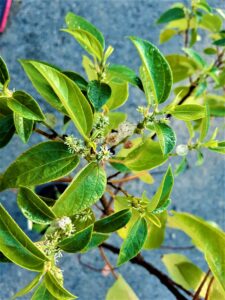
Forager’s delight attracts birds and butterflies
By Bruce Thompson
Common Name: Native Mulberry, White Nettle, False Stinger, Queensland Grass-Cloth Plant, Koomeroo-Koomeroo, Kongangn, Thil-la-wo
Genus: Pipturus
Species: argenteus
Family: Urticaceae
Origin: Occurs in coastal range lowland rainforests, on the edges of riverine communities and regrowth with occasional inundation, damp gullies and coral cays from Lismore to Papua New Guinea.
Characteristics: In the same family as Urtica incisa (Native Stinging Nettle) and Dendrocnide spp. (Stinging Tree). The common names, White Nettle and False Stinger, refer to the similar simple leaves, which are elliptical in shape, alternately arranged, finely toothed, 8-13mm long, three veined, dark green on top and dull silvery-white and hairy beneath – minus the sting!

A spreading shrub to 3m in height and width, with greyish brown bark with lenticels. The inflorescence is a spike of axillary, globular white flower clusters, both male and female. The spring- to summer-borne fruit is translucent to white, 4-6mm in diameter, resembles a tiny mulberry and is just as moreish as its exotic namesake.
The fast growing Native Mulberry is a dioecious plant for temporary damp areas, fruiting in both filtered light and full sun. Like other aggregate fruits, its seeds are on the outside. Native Mulberry needs to be cut back hard in dry periods. It is not frost tolerant.
Uses: Native Mulberry is a reliable fruiting and screen plant for shaded areas where a quick privacy screen to hide the neighbours is required. The fibrous bark was used traditionally for fishing nets. A brown dye used in cloth making was also obtained from the bark. The fruit was a favourite treat for First Nations people wherever it grew. Both ecologically and for permaculture gardens, Native Mulberry attracts frugivorous and insectivorous birds which hunt for the Pipturus weevil that feeds on the foliage. It is a habitat for the mistletoe bird, Victoria’s riflebird, silvereye, bridled, Macleays and Lewin’s honeyeaters. It is a larval species for many butterfly and moth species including Jezebels, Yellow Admirals, Speckled Line-Blue, Blue-Banded Eggfly, Varied Eggfly, Indigo Flash and hawk moths.
Propagation: By seed and cutting. Dehydrate the fruits, then scatter and lightly cover or squash fresh fruits into the germination media and lightly cover (this works for strawberries also).
Bruce Thompson is a dark sky conservationist, waste educator and a specialist in nocturnal flora and fauna conservation.
M: 0404 806 022
